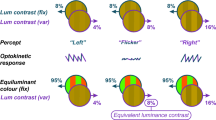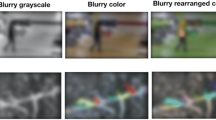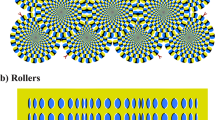Abstract
Moving stimuli are the most effective of all in eliciting blindsight. The detection of static luminance-matched coloured stimuli is negligible or even impossible in blindsight. However, moving coloured stimuli on an achromatic background have not been tested. We therefore tested two blindsighted hemianopes, one of them highly experienced and the other much less so, to determine whether they could perform what should be one of the simplest of all motion tasks: detecting when an array of coloured stimuli moves. On each trial, they were presented in the hemianopic field with an array of spots, all red or green or blue or achromatic, in a circular window and on a white surround. The spots moved coherently in the first or second of two short intervals. The subject had to indicate the interval in which the motion had occurred. The luminance of the spots was varied across different blocks of trials, but the background luminance remained the same throughout. For each colour, there was a ratio of luminance between the spots and the white surround at which performance was not significantly better than chance, although at other ratios, performance was good to excellent, with the exception of blue spots in one subject. We conclude that detecting global coherent motion in blindsight is impossible when it is based on chromatic contrast alone.

Similar content being viewed by others
References
Alexander I, Cowey A (2009) The cortical basis of global motion detection in blindsight. Exp Brain Res 192:407–411
Alexander I, Cowey A (2010) Edges, colour and awareness in blindsight. Conscious Cogn 19:520–533
Azzopardi P, Cowey A (2001) Motion discrimination in cortically blind patients. Brain 124:30–46
Azzopardi P, Fallah M, Gross CG, Rodman HR (2003) Response latencies of neurons in visual areas MT and MST of monkeys with striate cortex lesions. Neuropsychologia 41:1738–1756
Barbur JL, Ruddock KH, Waterfield VA (1980) Human visual responses in the absence of the geniculo-calcarine projection. Brain 103:905–928
Barbur JL, Watson JD, Frackowiak RSJ, Zeki S (1993) Conscious visual perception without V1. Brain 116:1293–1302
Baseler HA, Morland AB, Wandell BA (1999) Topographic organization of human visual areas in the absence of input from primary cortex. J Neurosci 19:2619–2627
Brent PJ, Kennard C, Ruddock KH (1994) Residual colour vision in a human hemianope: spectral responses and colour discrimination. Proc Roy Soc Lond B 256:215–219
Brett AS, Grünert U, Martin PR (2008) Retinal ganglion cell inputs to the koniocellular pathway. J Comp Neurol 510:251–268
Bridge H, Thomas O, Jbabdi S, Cowey A (2008) Changes in connectivity after visual cortical brain damage underlie altered visual function. Brain 131:1433–1444
Cowey A (2010) The blindsight Saga. Exp Brain Res 200:3–23
Cowey A, Alexander I, Heywood C, Kentridge R (2008) Pupillary responses to coloured and contourless displays in total cerebral achromatopsia. Brain 131:2153–2160
Cowey A, Alexander I, Stoerig P (2011) Transneuronal retrograde degeneration of retinal ganglion cells and optic tract in hemianopic monkeys and humans. Brain 134:2149–2157
Ffytche DH, Skidmore BD, Zeki S (1995a) Motion-from-hue activates area V5 of human visual cortex. Proc R Soc Lond 260:353–358
Ffytche DH, Guy CN, Zeki S (1995b) The parallel visual motion inputs into areas V1 and V5 of human cerebral cortex. Brain 118:1375–1394
Gegenfurtner KR, Kiper DC, Beusmans JMH, Carandini M, Zaidi Q, Movshon JA (1994) Chromatic properties of neurons in macaque MT. Visual Neurosci 11:455–466
Girard P, Salin PA, Bullier J (1992) Response selectivity of neurons in area MT of the macaque monkey during reversible inactivation of area V1. J Neurophysiol 67:1437–1446
Guo K, Benson PJ, Blakemore C (1998) Residual motion discrimination using colour information without primary visual cortex. NeuroReport 9:2103–2107
Heywood CA, Cowey A (2003) Colour vision and its disturbances after cortical lesions. In: Fahle M, Greenlee M (eds) The Neuropsychology of Vision. Oxford University Press, Oxford, pp 259–281
Heywood CA, Cowey A, Newcombe F (1991) Chromatic discrimination in a cortically colour blind observer. Eur J Neurosci 3:802–812
Holliday IE, Anderson SJ, Harding GFA (1997) Magnetoencephalographic evidence for non-geniculostriate visual input to human cortical area V5. Neuropsychologia 35:1139–1146
Morland AB, Le S, Carroll E, Hoffmann MB, Pambakian AL (2004) The role of spared calcarine cortex and lateral occipital cortex in the responses of human hemianopes to visual motion. J Cog Neurosci 16:204–218
Pavan A, Alexander I, Campana G, Cowey A (2011) Detection of first and second-order global motion in blindsight. Exp Brain Res 214:261–271
Riddoch G (1917) Dissociations of visual perceptions due to occipital injuries, with especial reference to appreciation of movement. Brain 40:15–57
Rodman HR, Gross CG, Albright TD (1989) Afferent basis of visual response properties in area MT of the macaque. I. Effects of striate cortical removal. J Neurosci 9:2033–2050
Roy S, Jayakumar J, Martin PR, Dreher B, Saalmann YB, Hu D, Vidyasagar TR (2009) Segregation of short-wavelength-sensitive (S) cone signals in the macaque dorsal lateral geniculate nucleus. Eur J Neurosci 30:1517–1526
Schenz T, Zihl J (1997a) Visual motion perception after brain damage: I. Deficits in global motion perception. Neuropsychologia 35:1289–1297
Schenz T, Zihl J (1997b) Visual motion perception after brain damage: II. Deficits in form-from-motion perception. Neuropsychologia 35:1299–1310
Schmid MC, Mrowka SW, Turchi J, Saunders RC, Wilke M, Peters AJ, Ye FQ, Leopold DA (2010) Blindsight depends on the lateral geniculate nucleus. Nature 466:373–377
Sincich LC, Park KF, Wohlgemuth MJ, Horton JC (2004) Bypassing V1: a direct geniculate input to area MT. Nat Neurosci 7:1123–1128
Szmajda BA, Grunert U, Martin PR (2008) Retinal ganglion cell inputs to the koniocellular pathway. J Comp Neurol 510:251–268
Zeki S, Ffytche DH (1998) The Riddoch syndrome: insights into the neurobiology of conscious vision. Brain 121:25–45
Acknowledgments
Our research was supported by an EPA Cephalosporin Trust Grant to IA and a Leverhulme Emeritus Fellowship to AC. We thank the hemianopic subjects and the sighted control subjects for their willingness to carry out many hours of psychophysical testing.
Author information
Authors and Affiliations
Corresponding author
Rights and permissions
About this article
Cite this article
Alexander, I., Cowey, A. Isoluminant coloured stimuli are undetectable in blindsight even when they move. Exp Brain Res 225, 147–152 (2013). https://doi.org/10.1007/s00221-012-3355-6
Received:
Accepted:
Published:
Issue Date:
DOI: https://doi.org/10.1007/s00221-012-3355-6




